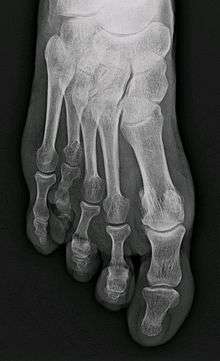Brachymetatarsia
Brachymetatarsia or hypoplastic metatarsal is a condition in which there is one or more abnormally short or overlapping toes metatarsals.[1] This condition may result due to a congenital defect or it may be an acquired condition.[1] It most frequently involves the fourth metatarsal. If it involves the first metatarsal, the condition is known as Morton's syndrome.[1] Treatment is via a number of differing surgical procedures.[1]


Differential diagnosis
Congenital causes include: Aarskog syndrome and Apert syndrome among many other well acquired causes includes trauma.[1]
Epidemiology
Brachymetatarsia is found to occur more frequently in women than men.[1]
Treatment
In cases you can treat the symptoms by wearing wider shoes which relieves pressure from the toes or you can wear padding around the toes. If the pain and discomfort cannot be treated, surgery is an option. In this procedure, the short metatarsal is usually cut and a piece of bone is grafted between the two ends. In some cases an external fixator my be attached to the metatarsal with pins. Within the external fixator there is a screw that must be turned (per your doctors orders) to lengthen the bone to the appropriate size.
Following surgery crutches or a knee scooter should be used as all weight must be kept off the surgically repaired foot for 3 months. Afterwards your doctor may place you in a boot or snug fitting shoe.[2]